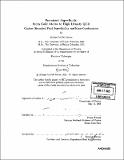Fermionic superfluids : from cold atoms to high density QCD : gapless (breached pair) superfluidity and kaon condensation
Author(s)
Forbes, Michael McNeil
DownloadFull printable version (9.462Mb)
Other Contributors
Massachusetts Institute of Technology. Dept. of Physics.
Advisor
Frank Wilczek.
Terms of use
Metadata
Show full item recordAbstract
In this thesis, we explore aspects of fermionic superfluidity through a mean-field approximation. Our framework is extremely general, includes both pairing and Hartree-Fock contributions, and is derived rigorously from a variational principle. This framework allows us to analyze a wide range of fermionic systems. In this thesis, we shall consider two-species nonrelativistic atomic systems with various types of interactions, and relativistic QCD systems with 3 x 3 x 4 = 36 different quark degrees of freedom (3 colours, 3 flavours, and 4 relativistic degrees of freedom). We discuss properties of a new state of matter: gapless (Breached Pair) superfluidity, and include a summary of potential experimental realizations. We also present numerical results for a completely self-consistent approximation to the NJL model of high-density QCD and use these results to demonstrate a microscopic realization of kaon condensation. We describe how to match the mean-field approximation to the low-energy chiral effective theory of pseudo-Goldstone bosons, and we extract the numerical coefficients of the lowest order effective potential.
Description
Thesis (Ph. D.)--Massachusetts Institute of Technology, Dept. of Physics, 2005. Includes bibliographical references (p. 189-198).
Date issued
2005Department
Massachusetts Institute of Technology. Department of PhysicsPublisher
Massachusetts Institute of Technology
Keywords
Physics.